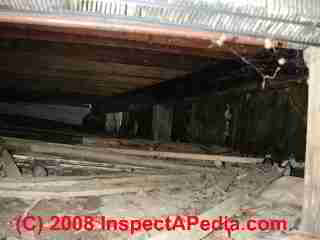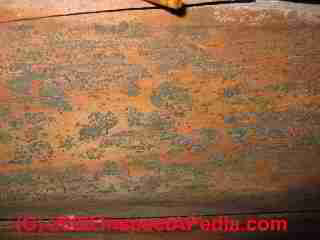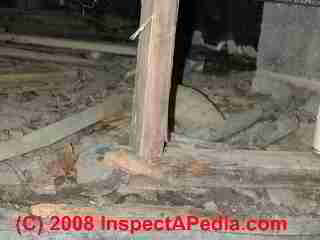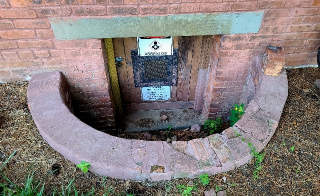 Crawl Space Safety
Crawl Space Safety
Checklist of Unsafe Crawl Space Conditions
- POST a QUESTION or COMMENT about safety hazards in building crawl spaces
This article lists potentially dangerous or unhealthy conditions that should be evaluated by an inspector or worker who is expected to enter, inspect, or work in a crawl space anywhere in a building.
The crawl space shown in our page top photo, located on the Vassar College campus (Poughkeepsie NY) is locked and carries two CRAWL SPACE WARNING LABELS [image file] warning of asbestos hazard, protective gear rquired, and thus, crawl space access restrictions.
At a property inspection, the decision to enter or not a crawl space or any other area that the inspector may believe is unsafe or inaccessibble is made by the inspector on the scene, not by anyone else.
InspectAPedia tolerates no conflicts of interest. We have no relationship with advertisers, products, or services discussed at this website.
- Daniel Friedman, Publisher/Editor/Author - See WHO ARE WE?
Crawl Space Safety for Home Inspectors
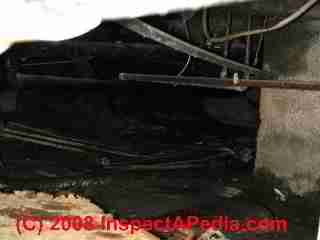 Is the crawl space safely accessible, or accessible at all?
Is the crawl space safely accessible, or accessible at all?
A number of conditions besides the old saw "accessibility" or size of the crawl space opening should be considered carefully by the home inspector, electrical inspector, or anyone who is deciding if it is safe to enter an crawl area anywhere in a building.
[Click to enlarge any image]
This article provides a list of some safety and health considerations that the building or home inspector or anyone else should evaluate before deciding to enter a crawl space.
Separately at CRAWL SPACE ACCESS we describe codes & standards for accessing building crawl spaces and we describe methods used to enter or inspect crawl areas that are not accessible by normal means of an available hatch or opening or that lack adequate safe space for entry.
- Is there standing water in the crawl area?
If the crawl space has areas of puddles or standing water or even if the soil surface is simply wet there is risk of electrical shock (if wiring or electrical devices are present).
There may also be a chemical contamination risk, especially in older buildings where pesticides may have been applied in the crawl area.
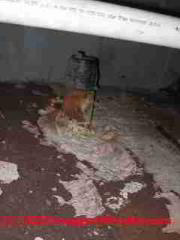
- Are there or were there previously wet areas in the crawl space?
Is there evidence of previous wetting or burst sewer piping or sewage backups or spills? - Watch out for sewage backups & spills in the crawl area. Entering sewage-contaminated areas, even if currently dry, is unsafe unless you are wearing proper protective gear.
Hazards include both wet sewage pathogens and even airborne or dust-borne dry pathogens.
Our photo (left) illustrates a crawl area that is hazardous: we see toilet paper around an abandoned sewer line access or cleanout (now capped off) and we see a newer PVC waste line overhead. Consider the sewage pathogen risks to workers who capped the old waste line and installed the new one.
The sewage-contaminated soil surface debris should have been removed, the area sanitized, and it may have made sense to install new clean plastic ground cover in this area.
See CRAWL SPACE SEWAGE CLEANUP
For technical details also see SEWAGE PATHOGENS in SEPTIC SLUDGE
- Is there excessive debris in the crawl area? Nails, splinters, and possibly rodents may be in the debris in our photo at left.
- Are there wet crawl area floors or other surfaces? Crawling exposes a lot of body surface to the ground or other surfaces and limits movement. There maybe shock hazards or chemical hazards even if there is not actual standing water.
Beware also of evidence of structural collapse when looking at a flooded or very wet crawl space. Piers are undermined, foundations may be collapsing. - Are there chemical odors in the crawl space?
If so there is an increased risk of chemical contaminants that could be hazardous. You should not enter such an area without proper protective clothing, respirator, etc.

- Is there evidence of asbestos insulation, especially disturbed,damaged, or deteriorated asbestos insulation?
Do not enter such an area without protective equipment; take care that you do not track hazardous materials out of the crawlspace and into other building areas.
Often we find a crawl area in which the asbestos pipe insulation is not just hanging (photo at left) but has fallen onto the crawl space floor.
- Is there evidence of mold contamination such as areas of wood, paper, or other material covered with mold or mold-suspect material. Do not enter such an area
without the required PROTCTIVE GEAR for ENTERING CRAWL SPACES
Watch out: for crawl space mold hazards we provide separate warning information
at CRAWLSPACE MOLD ADVICE.
Do not enter such an area without protective gear and appropriate training.
- Is there evidence of rodents or snakes or insect pests in the crawl space? Rodent hazards include bacterial and viral and respiratory illness; there is the obvious risk of snake bites in a confined space, and more than once we've been run out of a crawl space by bees or hornets.
But since you're unlikely to be able to move rapidly to make an emergency retreat from threatening pests, crawl areas are riskier than some other building areas.
Evidence of pests may also suggest risk of improperly applied and unsafe exposure to pesticides.
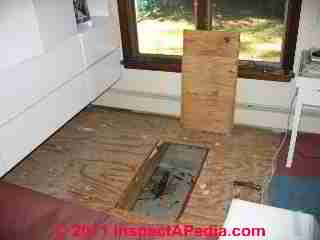
- Is there sufficient space for safe access to enter and move safely in the crawl area. Review the OSHA regulations on entering confined spaces. The inspector or worker should decide if s/he a building area is safely accessible.
Do not enter a confined space if you are working alone at a property. If circumstances mean you cannot avoid such an entry, be sure you carry:- A working cell phone that will function in the space
- A spare flashlight
- Appropriate protective gear
- A camera to use for documenting conditions - it's easier than dragging along clipboards and pens.
- Is there wet or falling or rodent-infested fiberglass insulation in the crawl area? If so there is a high risk of mold or rodent contaminants that could present a fungal, bacterial, or viral airborne hazard.
Do not enter such an area without proper protective gear.
See MOLD in FIBERGLASS INSULATION
- Is there evidence of risk of structural collapse or even structural movement in or over the crawl area?
Look closely at columns, posts, piers, girders, joists, and perimeter foundations.
It is easy to become pinned or even crushed if you enter an unstable structure.
Examples of Crawl Space Safety Gear for Entering Crawl Spaces & Mold Contaminated Areas
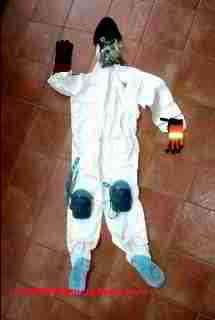 These crawl space safety suggestions are not an exhaustive inventory of all safety procedures nor gear should be used when entering a crawl space. Additional protective equipment and even accompaniment, breathing apparatus, and rescue gear may be required according to building structure, safety, and other conditions.
These crawl space safety suggestions are not an exhaustive inventory of all safety procedures nor gear should be used when entering a crawl space. Additional protective equipment and even accompaniment, breathing apparatus, and rescue gear may be required according to building structure, safety, and other conditions.
- Assistant or accomplice: do not enter an unsafe or confined space alone - station an assistant at the entry and maintain contact.
- Battery operated flash light and spare flash light. A spare light is important if the crawl area is large and you could be fare from the entry - to avoid being trapped in darkness if your first light fails.
Watch out: Dragging an extension cord and trouble light into a crawl area, powered by plugging the extension cord into a wall receptacle is dangerous unless the cord is protected by GFCI and AFCI devices. - Cell phone or two way radio - to summon help in an emergency
- Eye protection - in dusty areas full coverage eye protection or goggles are most secure; in low-dust areas eye protection such as the safety glasses in our photo below have the advantage of less tendency to fog up in humid work areas.
- Gloves - to protect hands especially if you need to crawl. The very thick welder's glove on our mock-up photo's right hand offers the good dry-area protection but makes it almost impossible to handle a camera or other equipment. For wet areas we wear heavy rubber padded gloves.
- Knee pads - we like the gel-type knee pads shown in our mock-up photo - they make crawling easy on the knees, and their thickness keeps the legs and knees up off of damp surfaces.
- Protective clothing - jump suit, tyvek suit (shown in our photo), padded clothing
- Respirator, with cartridges rated for both organic chemicals and fine particulates - a HEPA filter and charcoal filter or other special filters may be required. Do not rely on a simple paper dust mask.
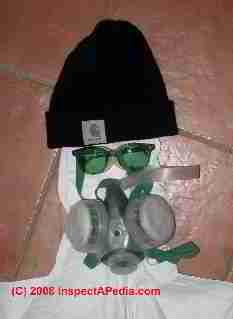
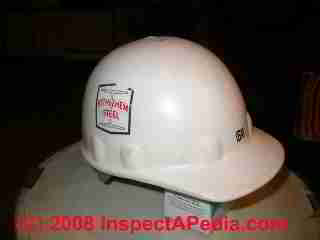
- Head protection - depending on space this may be a hard hat or if that is impractical because of limited space, a soft padded hat may be useful.
Watch out: for protruding nails or other sharp objects that can poke right through a soft hat like the one we show at left.
Readers whose crawl space or basement have been flooded should also
see FLOODS IN BUILDINGS-priorities.
...
Continue reading at CRAWL SPACE ACCESS or select a topic from the closely-related articles below, or see the complete ARTICLE INDEX.
Or see CRAWL SPACE SAFETY FAQs - questions & answers posted originally on this page
Recommended Articles
Suggested citation for this web page
CRAWL SPACE SAFETY ADVICE at InspectApedia.com - online encyclopedia of building & environmental inspection, testing, diagnosis, repair, & problem prevention advice.
Or see this
INDEX to RELATED ARTICLES: ARTICLE INDEX to CRAWL SPACES
Or use the SEARCH BOX found below to Ask a Question or Search InspectApedia
Ask a Question or Search InspectApedia
Try the search box just below, or if you prefer, post a question or comment in the Comments box below and we will respond promptly.
Search the InspectApedia website
Note: appearance of your Comment below may be delayed: if your comment contains an image, photograph, web link, or text that looks to the software as if it might be a web link, your posting will appear after it has been approved by a moderator. Apologies for the delay.
Only one image can be added per comment but you can post as many comments, and therefore images, as you like.
You will not receive a notification when a response to your question has been posted.
Please bookmark this page to make it easy for you to check back for our response.
IF above you see "Comment Form is loading comments..." then COMMENT BOX - countable.ca / bawkbox.com IS NOT WORKING.
In any case you are welcome to send an email directly to us at InspectApedia.com at editor@inspectApedia.com
We'll reply to you directly. Please help us help you by noting, in your email, the URL of the InspectApedia page where you wanted to comment.
Citations & References
In addition to any citations in the article above, a full list is available on request.
- [1]U.S. City or State Adopted versions of the model buiding code produced by ICC Section R408, Under Floor Space, http://publicecodes.cyberregs.com/icod/irc/2012/icod_irc_2012_4_sec008.htm, retrieved 3/2/2013
See these City or State Adopted versions of the model buiding code produced by ICC Section M1305.1.4 [PDF] Section M1305.1.4 for access requirements where mechanical equipment is located under floors. - [2]U.S. City or State Adopted versions of the model buiding code produced by ICC Section R406, Foundation Waterproofing and Dampproofing, http://publicecodes.cyberregs.com/icod/irc/2012/icod_irc_2012_4_sec006.htm, retrieved 3/2/2013
- Electrical shock injury statistics: www.healthatoz.com - September 2008;
- Mark Cramer Inspection Services Mark Cramer, Tampa Florida, Mr. Cramer is a past president of ASHI, the American Society of Home Inspectors and is a Florida home inspector and home inspection educator. Mr. Cramer serves on the ASHI Home Inspection Standards. Contact Mark Cramer at: 727-595-4211 mark@BestTampaInspector.com
- "How to Use DMM's Safely," Leonard Ogden, CEE News, 888 Seventh Ave., New York, NY 10106, Dec 1990 p.10.
- Dr. Jess Aronstein, consulting engineer, Poughkeepsie NY, 1991 protune@aol.com
- Rex Cauldwell, master electrician and contributor to the Journal of Light Construction on electrical topics
- New York State Central Hudson Gas and Electric Company, G&E/1-2/85 consumer safety pamphlet
- American Society of Home Inspectors, ASHI Training Manual, Al Alk -[obsolete, and includes unsafe practices-DF]
- * Safety Hazards and Safe Inspection Procedures for Electrical and Home Inspectors at Residential Electric Panels
- BASEMENT MOISTURE CONTROL [PDF] U.S. Department of Energy
- CRAWL SPACE MOISTURE CONTROL [PDF] U.S. Department of Energy
- Diagnosing & Repairing House Structure Problems, Edgar O. Seaquist, McGraw Hill, 1980 ISBN 0-07-056013-7 (obsolete, incomplete, missing most diagnosis steps, but very good reading; out of print but used copies are available at Amazon.com, and reprints are available from some inspection tool suppliers). Ed Seaquist was among the first speakers invited to a series of educational conferences organized by D Friedman for ASHI, the American Society of Home Inspectors, where the topic of inspecting the in-service condition of building structures was first addressed.
- Domestic Building Surveys, Andrew R. Williams, Kindle book, Amazon.com
- Defects and Deterioration in Buildings: A Practical Guide to the Science and Technology of Material Failure, Barry Richardson, Spon Press; 2d Ed (2001), ISBN-10: 041925210X, ISBN-13: 978-0419252108. Quoting:
A professional reference designed to assist surveyors, engineers, architects and contractors in diagnosing existing problems and avoiding them in new buildings. Fully revised and updated, this edition, in new clearer format, covers developments in building defects, and problems such as sick building syndrome. Well liked for its mixture of theory and practice the new edition will complement Hinks and Cook's student textbook on defects at the practitioner level. - Guide to Domestic Building Surveys, Jack Bower, Butterworth Architecture, London, 1988, ISBN 0-408-50000 X
- In addition to citations & references found in this article, see the research citations given at the end of the related articles found at our suggested
CONTINUE READING or RECOMMENDED ARTICLES.
- Carson, Dunlop & Associates Ltd., 120 Carlton Street Suite 407, Toronto ON M5A 4K2. Tel: (416) 964-9415 1-800-268-7070 Email: info@carsondunlop.com. Alan Carson is a past president of ASHI, the American Society of Home Inspectors.
Thanks to Alan Carson and Bob Dunlop, for permission for InspectAPedia to use text excerpts from The HOME REFERENCE BOOK - the Encyclopedia of Homes and to use illustrations from The ILLUSTRATED HOME .
Carson Dunlop Associates provides extensive home inspection education and report writing material. In gratitude we provide links to tsome Carson Dunlop Associates products and services.


